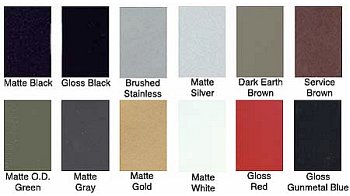How to Clear-Coat Laminated Wood Stocks
![]()
Laminated wood stocks offer an excellent combination of price and performance, and they can be obtained in a myriad of styles to suit your discipline — hunting, benchrest, tactical, silhouette, or high power. Laminated stocks can be a little trickier to finish compared to a hardwood such as walnut, as laminates are often delivered in bright or highly contrasting colors. Traditional wood finishes can alter the colors. Also, filling the pores in laminated stocks is an issue.
Automotive clear-coat products have become popular for finishing laminated wood stocks because they won’t alter the stock’s colors, and the clear-coat provides a durable weather-resistant finish. Clear-coat is also easy to “touch up” and it fills pores better than some other alternatives. Mike Ricklefs has written a comprehensive article on stock painting that includes a special section on clear-coating over laminated woods. If you want to clear-coat a stock, Mike’s article is a must-read!
| In that Stock Painting Article, Mike offers these tips:
1. When finishing laminated stocks with clear-coat, you need to prepare the wood carefully, and build up quite a few thin layers one at a time. Begin by sanding, with progressively finer paper, all the way to 400 grit. Certain laminated stocks are so rough when they come from the stock-maker, that you may have to be very aggressive at first. But be careful with angles and the edges of flats. You don’t want to round these off as you sand. 2. After sanding, use compressed air to blow out all dust from the pores of the wood. This is very important to avoid a “muddy” looking finish. If you don’t blow the dust out with air before spraying the clear it will migrate out as you apply the clear. Also, after each sanding session, clean your painting area to remove excess dust. I also wet down the floor of my spray booth to keep the dust down. 3. Some painters recommended using a filler to close the pores. That’s one technique, but the filler can detract from the clarity of the final finish. Rather than use a pore-filling sealer, I use a high solids or “build” clear for the initial applications. This is slightly thicker than “finish” clear and does a good job of sealing the pores. Three (3) fairly heavy coats of “build” clear are applied. If you get a thick spot or a run in the finish at this point, it is not the end of the world but this does create more sanding work.” |
There is a helpful thread in our Shooters’ Forum that discusses the use of clear-coating on laminated stocks. Member BHoges offered this advice: “Stick with Diamont, Glassurit, and Spies. If anyone has questions, I painted cars for a long time.”
Forum member Preacher, whose bolt-action pistol is shown at right, states: “I buy my two-part clear-coat from the local NAPA dealer. They recommended Crossfire mixed 4:1. I really like the end results. There are six coats on that stock that were sanded down to bare wood for the first two, and then 600 wet-sanded for the other four coats. Two to three coats would be sufficient if the pores were filled first, but I would rather fill ‘em with the clear as it seems to make it appear deeper and I have the time to devote to it. I have PPG’s Deltron DC 3000 clear-coat on a few stocks of mine, but I like the NAPA better price wise, and it seems to hold up just as good as the Deltron.”



















